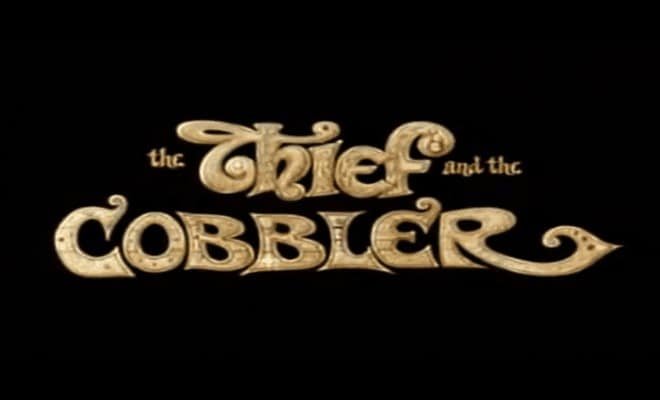Richard Williams’ Untold Story

A Christmas Carol. Who Framed Roger Rabbit? Raggedy Anne & Andy. Each an animated masterpiece of its own. If you have seen one of these films, you have seen the work of animator Richard Williams. His many works have amassed a collection of awards for Williams, including 3 Academy Awards and an Emmy. Now in his 80s, Williams has mostly stepped away from animation to focus on his how-to book titled The Animator’s Survival Kit. While there is no denying Williams’ skill in the art of animation, his greatest masterpiece will never be realized.
The Troubled History
Intended to be the magnum opus of Richard Williams’ career, The Thief and the Cobbler is famous for both its unusual animation style and troubled development history. The movie itself is a hand-drawn epic inspired by the Arabian Nights, with production beginning in 1964. Other famous animators contracted to the film include Art Rabbit and Ken Harris. Sadly, for Williams, his masterpiece became a 30-year animated nightmare for himself and most of the crew.
Story Changes
The film went through many story changes during its 30-year production run. Williams lost the rights to his original script after a falling-out with the family who worked as his translator. After the production snag, the next script included unique characters and a plot loosely based on the themes in the Arabian Nights.
Funding
An issue with animated films, especially one of The Thief and the Cobbler‘s scale, is keeping the funding. For most of its development, Williams funded The Thief and the Cobbler himself. In 1978, an Arabian prince chose to fund a ten-minute test sequence for the movie. Despite his positive response, he chose not to fund the rest of the production because of missed deadlines and surpassed budget. Williams had another chance at funding his project after the success of Who Framed Roger Rabbit from Warner Brothers, which finally pushed the animated film into full production. However, it faced similar issues under Warner Brothers’ control: continuously missed deadlines and surpassed production budgets.
Aladdin
The Thief and the Cobbler faced another major issue in 1991 as it neared completion. Disney released their animated Arabian tale titled Aladdin. Upon comparison, the films share some striking resemblances in the story and style and characters. Originally, The Thief and the Cobbler should have beat Aladdin into theaters and, due to another missed deadline, did not do so. Unfortunately, they continued production.
Loss of Creative Control
In the spring of 1992, the film had 15 minutes of screen time left to complete which would take six months. On May 13 of that year, Williams showed a rough version of the film to Warner Brothers, which disappointed the company. They removed themselves from the project and the Completion Bond Company seized the film. At that point, the company removed Richard Williams and replaced him with Fred Calvert.
Three Different Film Releases
The Princess and the Cobbler (1993)
Fred Calvert’s version of the movie only took 18 months to finish, with the newer scenes produced on a lower budget. His version also added two song sequences and removed 18 minutes of completed animation by Williams. They retitled the film to The Princess and the Cobbler, distributed in Australia and South Africa on September 23, 1993.
The Arabian Knight (1994)
In 1994, Miramax Films bought the distribution rights in North America. Harvey Weinstein made the executive decision to cut the film further and released this version under the title Arabian Knight. Unlike Williams’ silent version of the film, they added a celebrity voice cast that included Matthew Broderick and Jonathan Winters. It received mixed-to-negative reviews. After its first theatrical release, Miramax kept the film’s original title The Thief and the Cobbler for its VHS release in 1995.
The Thief and the Cobbler: Recobbled Cut (2006)
In 2006, Garrett Gilchrist created a non-profit fan restoration of The Thief and the Cobbler workprint. It was a true labor of love for Gilchrist, a filmmaker and artist. He removed the celebrity voiceovers and song sequences, adding rare material from the other animators who worked on the film to make it feel complete. Revised three times, each version took a step closer towards the movie’s original vision. Gilchrist’s work is the closest to Richard Williams’ vision of The Thief and the Cobbler that we will ever see. His YouTube account, TheThiefArchive, holds four different versions of the Recobbled Cut and they are viewable here.
Persistence of Vision
Persistence of Vision, a 2012 documentary by Kevin Schreck, details the production of The Thief and the Cobbler. The documentary’s tagline calls the work ‘the greatest animated film never made’. Williams refuses to discuss his failed production, so he is not in the documentary outside of archival interviews. Schreck utilizes the animators and artists who worked on the film to build a better understanding of what The Thief and the Cobbler was to Williams. While Richard Williams has received a copy of the film, he does not plan to watch. However, like the Recobbled Cut, the documentary is worth the watch and is viewable here.
Richard Williams’ masterpiece will never be the way that he intended it. The animator claims he will never revisit the project because of the tumultuous journey it took him on. Despite that, The Thief and the Cobbler is worth the watch. The film itself is an animated masterpiece with quite the interesting set of history behind it. If you intend to watch the Calvert or Miramax cuts for the celebrity voice cast or musical numbers, I recommend the Recobbled Cut first. It is free to watch on YouTube while the other versions are more difficult to find. It truly is the greatest animated film never made.










